
Originally published 10 August 2021.
On 24 July 2021, anti-lockdown protests across Australia led to chaotic scenes and arrests. Presented as demonstrations against Australia’s pandemic restrictions, the protests were also branded as part of a ‘World Wide Rally for Freedom’, leading to speculation about the relationship between domestic events and a global movement.
The demonstrations attracted a broad range of protesters and were promoted across chat and social media platforms such as Twitter, Facebook and Instagram. The messaging app Telegram appears to have played an important role in facilitating coordination of protests and dissemination of material between global and domestic accounts.
ASPI’s International Cyber Policy Centre has examined 12 Australian Telegram public discussion and announcement channels on which protest planning took place and two international channels. The analysis was not intended to be exhaustive, but looked at channels organising under the banner of ‘Freedom Rally’ or ‘World Wide Demonstration’. The largest ‘World Wide’ channel had more than 72,000 subscribers by 5 August 2021. All told, Australian ‘Freedom Rally’ channels had almost 20,000 subscribers, although there’s likely to be significant crossover.
On Telegram, users can set up ‘groups’ to chat or ‘channels’ to broadcast messages. We analysed data on seven group discussion channels on which most of the activity appears to have taken place.
Anti-lockdown protests have occurred often during the pandemic. In 2020, during its second lockdown, Melbourne experienced demonstrations in September and November. Global anti-lockdown protests have continued, often under the broad brand of the World Wide Rally for Freedom and the hashtag #WewillALLbethere. The chart below shows the number of posts with this hashtag on Facebook, Twitter and Instagram between April and August 2021. Dashed lines mark the dates 20 March, 15 May and 24 July on which World Wide Rally for Freedom events were held.
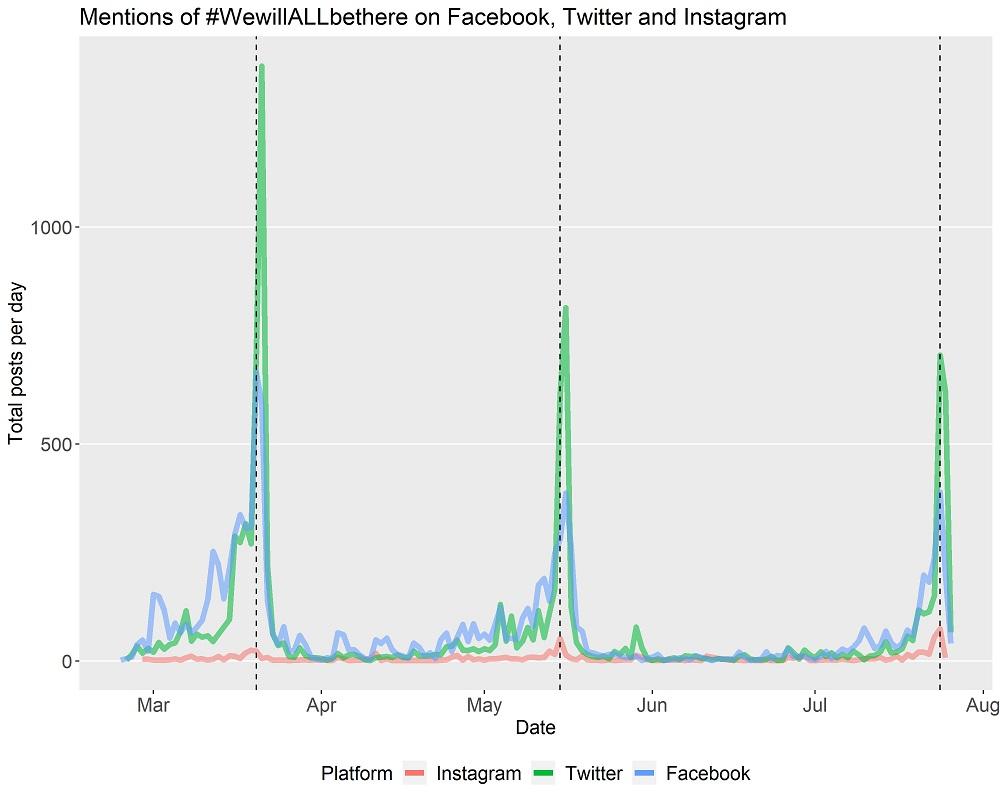
An investigation by the fact-checking organisation Logically suggested that the World Wide Rally for Freedom protests in March and May were ‘astroturfed’ by an organisation in Germany known as Freie Bürger Kassel (Free Citizens of Kassel). Logically analysed 20 ‘World Wide Demonstration’ protest Telegram groups and found that at least 13 of them were set up in the same hour on 28 February and began with similar messages. Telegram accounts associated with Freie Bürger Kassel also promoted the 24 July protest, and its graphics were replicated across Australian groups. This activity aligned with sharp increases in the number of unique accounts posting in the worldwide Freedom Rally Telegram discussion channel (see chart below).
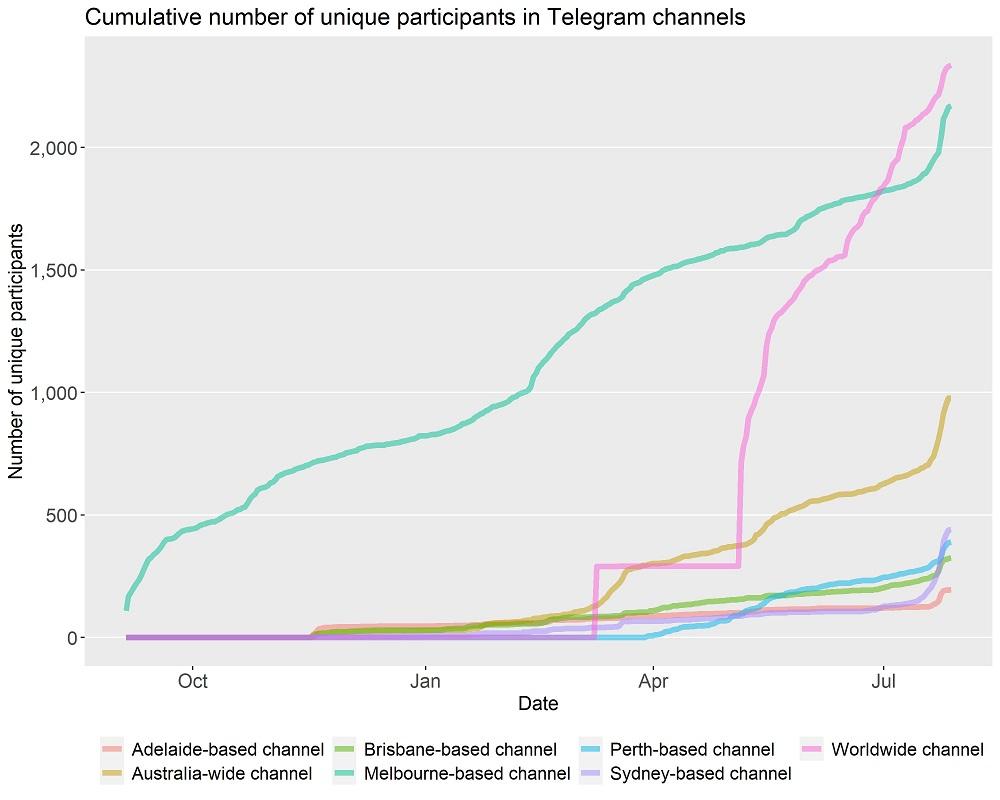
Unlike the selection of international Telegram channels examined by Logically, Australia-focused Telegram channels organised under the name ‘Freedom Rally’ were largely created before February 2021. Of the Freedom Rally Telegram channels set up for each major Australian city that we analysed, only the Perth channel was created after the launch of the ‘World Wide Demonstration Official’ channel on 18 February 2021. In general, Freedom Rally channels followed a similar organising principle, with one announcements channel and one chat group. Some had corresponding websites.
The Melbourne Freedom Rally channel appears to be the originator of the local Freedom Rally network, with a presence on a broad array of platforms, including Facebook, Twitter, Gab and Discord. Its main Telegram channel group has been active since at least 4 September 2020. The Adelaide, Sydney, Brisbane and Australia-wide Freedom Rally channels were created on 17 November 2020, with an organiser posting that the ‘Melbourne Freedom Rally is going Australia-Wide’. The organiser tells members to ‘DM the admins of Melbourne Freedom Rally to get in touch and build organizational teams locally’.
Unsurprisingly, messaging activity in Australian Freedom Rally channels generally tended to align with protests organised during lockdowns. Other than the Melbourne channel, most messaging in the Australian channels occurred after May 2021 (see chart below).
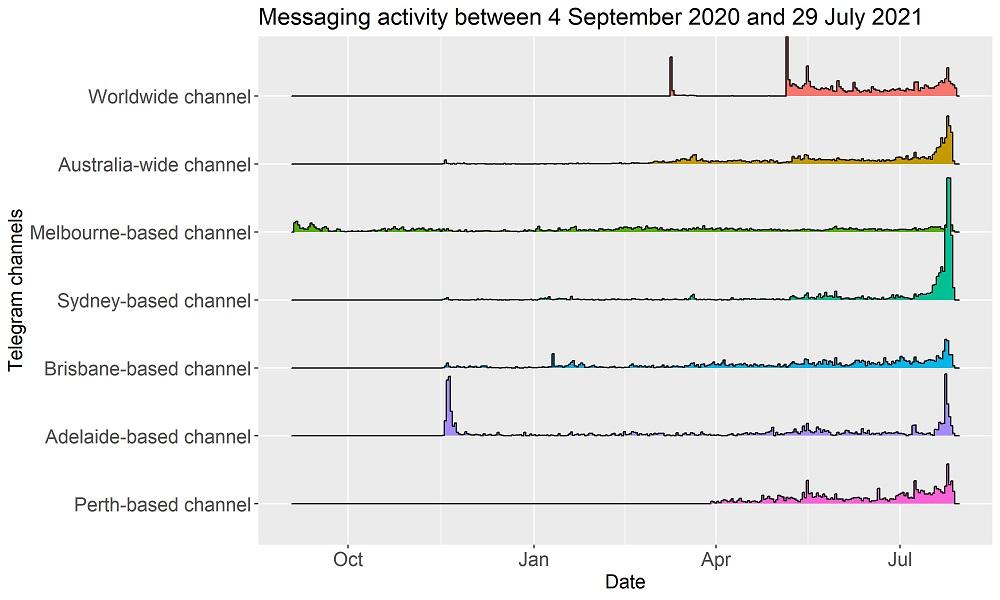
While the World Wide Demonstration channels followed the creation of most of the Australian groups, its message was quickly folded into the local ecosystem. Messages from its Telegram channel were being forwarded in Australian ‘Freedom Rally’ channels as early as 24 February 2021. And by early March, related events were heavily promoted. A 5 March 2021 press release from the ‘action group’ in Kassel, shared by the Melbourne channel, said it had received an overwhelming amount of support from many countries and was collaborating with organisers locally to deploy a wide variety of events.
On 5 March, one Sydney group user asked if the ‘World Wide Rally for Freedom’ was also planned for Sydney. A user named Dominic D (with an ‘organizer’ tagged account) replied that it would be, with ‘location to be announced soon’. In March 2021, The Guardian reported Dominic D’s real name to be Harrison McLean and explored his alleged ‘plans to introduce his “freedom” group to more radical political views’ (allegations he denied to the outlet). The Australia-wide Freedom Rally channel published a periodic list of ‘freedom’ channels to follow. These were forwarded into other channels. In January and February, this list included accounts associated with the Proud Boys and other far-right groups and media outlets.
A recorded Zoom call about the 20 March protest posted in the Melbourne channel on 17 March was tagged as the World Wide Rally for Freedom ‘Australian Team Zoom’. It included figures such as Fanos Panayides, who was notable in Melbourne’s 2020 anti-lockdown protests and a representative of the Informed Medical Options Party. In the clip, a man using a Zoom account tagged Harrison McLean says, ‘We’ve been working with an international coalition of people from over 100 cities around the world to put this event on.’ ‘Dominic D’ was active in every Telegram channel we analysed.
Analysis of the links and messages posted in six key Australian Freedom Rally Telegram discussion channels and in one worldwide Freedom Rally channel between 4 September 2020 and 29 July 2021 shows that they coordinate social media engagement across multiple platforms. Links to other Freedom Rally–associated social media accounts on Twitter, Facebook and Instagram were some of the most shared links in the channels (see chart below).
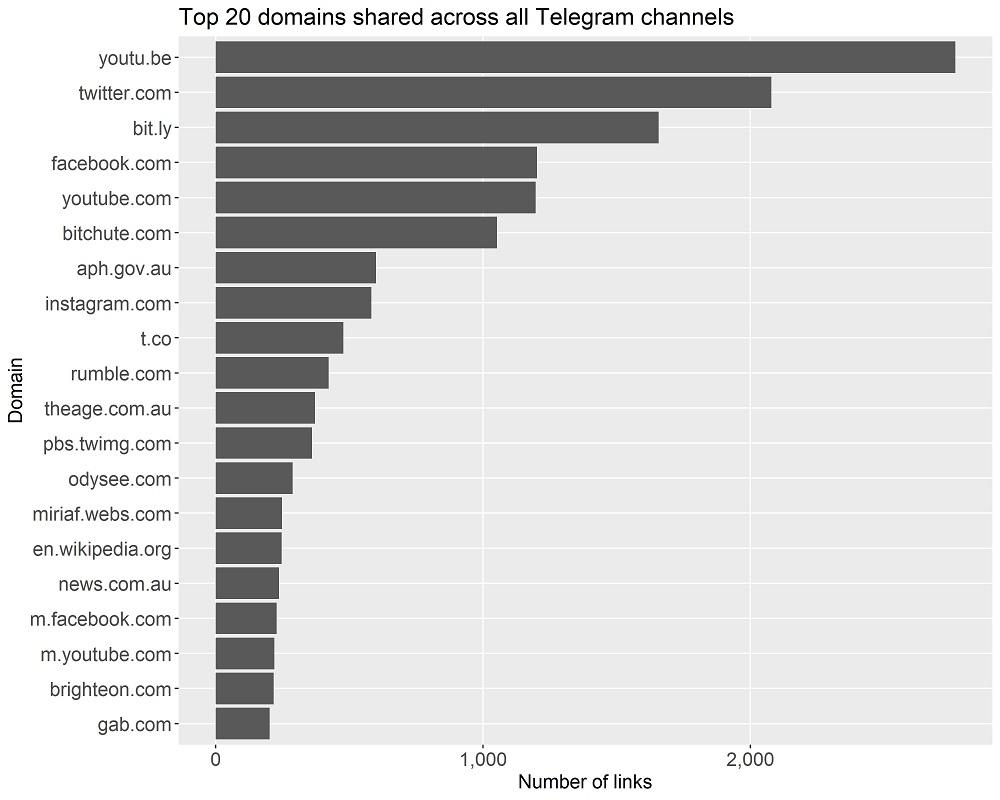
Videos were also shared from YouTube, BitChute and Rumble, and mostly contained anti-vaccine and conspiracy theory content. A petition on the Australian Parliament House website was shared 125 times and requested the government to ‘uphold the Nuremberg Code’ and not make ‘experimental vaccines’ mandatory. It accumulated more than 300,000 signatures.
Forwarded messages accounted for 24% of all traffic in Australian and worldwide Freedom Rally discussion channels. In total, 6,954 Telegram channels had messages forwarded to the Australian Freedom Rally channels, and 130 channels went to all seven channels. These included QAnon-related channels, anti-vaccine groups, Australian far-right groups, international far-right groups and Australian politicians. Posts from MP Craig Kelly’s Telegram channel were forwarded 238 times. Posts from Russian state-controlled television station RT’s official Telegram channel were forwarded 190 times into all the Freedom Rally channels, but mostly in the worldwide and Melbourne-based channels.
Content often referred to a roll call of conspiracy theories and misinformation about Covid-19 and the pandemic. The graphic below, for example, references Event 201. This was a pandemic simulation held in October 2019 by the Johns Hopkins Center for Health Security, the World Economic Forum, and the Bill & Melinda Gates Foundation—a regular target of Covid-19 disinformation. The event has been used by some to suggest that Gates had prior knowledge of the pandemic.
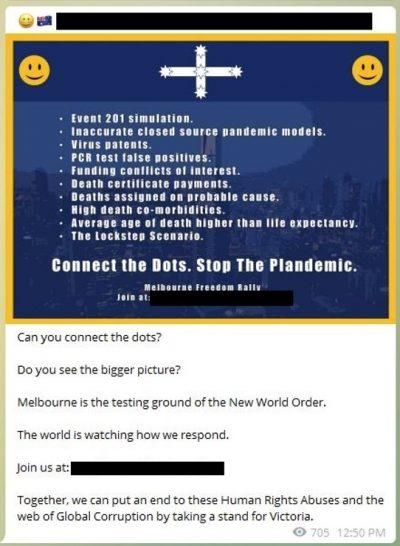
Text mining suggested that people on these Telegram channels regularly used terminology reflecting a deep distrust of public institutions. Terms such as ‘false flag’, ‘fake news’, ‘fake cops’, ‘fake protests’, ‘trap’, ‘false positives’, ‘media lies’ and ‘government lies’ were among the most frequent and showed up at least 834 times across all Telegram channels between 4 September 2020 and 29 July 2021. The phrase ‘fake news’ appeared at least 140 times in the Melbourne-based Telegram channel alone.
As Australia’s pandemic response continues, more lockdown protests are likely—fed by these organising channels and by a mix of social platforms, influencers and community members expressing genuine distress and grievance. The wide variety of platforms used by such groups illustrates their ability to switch between more mainstream platforms to promote events and less moderated environments where conspiracy theories and misinformation can proliferate.